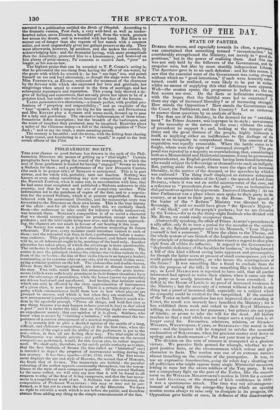PHILHARMONIC SOCIETY.
Tuts year chance or good fortune has thrown in the path of the Philharmonic Directors the means of getting up a" trial-night." Certain paragraphs have been going the round of the newspapers, in which the zeal of these gentlemen is lauded for having " engaged" SPOKE to write a Sinfonia for them ; and a performance of the new Dramatic Cantata (for such is its proper title) of BERLIOZ is anticipated. This is in part untrue, and the whole will, probably, turn out baseless. Nothing was known or even asked concerning any new composition of SPOHR till the Norwich Festival, when it Caine out, in conversation with him, that he had some time completed and published a Sinfonia unknown in this country, and that he was on the eve of completing another. This information led to the purchase of copies of the first, and to a negotiation for the second Sinfonia, which is at present unpublished. Seonn behaved with his accustomed liberality, and the manuscript score was forwarded to the Directors on their own terms. This is the true history of the atileir : and for all which they really did, we cordially thank them—the endeavour to take credit for industry wholly undeserved, was beneath them. Brutwoz's composition is of so novel a character that we should scarcely ainicipate its production except under his guidance ; and the trial-night being now over, and the season approaching, the chances are not muck in devour of our hearing it this year. The Society has come to a judicious derision respecting its future rehearsals. Till now, every member could introduce visitors to each of these ; and the rehearsal was thus, in fact, a performance before a numerous audience. This privilege is now abandoned, and future rehearsals will be, as all rehearsals ought to be, meetings of the band only. Another alteration has taken place, of which the advantage is more questionable. The orchestra is modelled on a plan entirely new in this country. The centre is now the principal violoncello, whence the violins radiate to the front of the orchestra ; the line of first violiu (there is no longer a leader) terminating at its extreme edge on one side, and the second violins occupying a similar position on the left. The violoncellos and double-basses, driven from their 'vantage-ground, are dotted at distant intervals in the rear. Two evils result from this arraugement,—the acute instruments (which were sufficiently prominent in their former situation) have now the advantage of precedence, while the basses (never too powerful) are driven badh ward and smothered. And besides, that intimate union which can only be effected by the close approximation of instruments of a given class, is now destroyed. There is a certain degree of sympathy which communicates itself from bow to bow when players are grouped in masses, and which is lost when they are scattered. The new arrangement is probably experimental, not final. There is much wisdom in the apostolic precept, "Prove all things, and hold fast (not to any thing, because you may happen to have proved it, hut) to that which is good :" and it is under the idea that on Saturday night we witnessed an experiment merely, that our opinion of it is given. Soldiers, who know what is meant by "clubbing a battalion," will understand the importance of a correct arrangement of a musical regiment. • It is scarcely fair to give a decided opinion of the merits of a long, difficult, and elaborate composition, played for the first time, when the correctness of the copies and the ability of the performers is put to the test—when, in fact, all are feeling their way. The trial-night of the Philharmonic was strictlyprivate ; and public criticism on the several contpositions perfialned, would, for this reason also, be rather impertinent. We shall only, therefore, so far satisfy public curiosity as to state, that the first Sinfonia of SPORE (by him called an "historical" one) is intended to depit the progress of instrumental writing during the last century. It has three epochs-1740, 17110, 1840. The first movement displays the age and style of HANDEL, the second that of MOZART, the finale that of A CUER. The transcripts are fitithful : the peculiar colouring of tile author appears occasionally throughout, but the resemblance to the style of each composer is perfect. Of the second Sinfonia by the same writer, we will only say now that it will lie found in all respects worthy of the first of living composers, and that the last movement is a magnificent work ofart. A Sinfonia was also rehearsed, the composition of Professor WALMISLEY : this may or may not be per. formed, as it has yet to await the decision of the Directors. 'We have no right to criticize a work which is not before the public, and therefore abstain from adding any thing to the simple announcement of the fact.


























 Previous page
Previous page